Emergency Communication System Based on Wireless LPWAN and SD-WAN Technologies: A Hybrid Approach
Abstract
1. Introduction
2. Related Work
3. An Overview of LoRaWAN and SD-WAN Technologies
3.1. LoRaWAN Technology
Security Options
- application session key—AppSKey,
- end-device address—DevAddr, and
- network session key—NwkSKey.
- Personalization Activation (PA)
- Activation Over-the-Air strategy
- application identifier—AppEUI,
- end-device identifier—DevEUI and
- application key—AppKey.
3.2. WAN and SD-WAN Technologies
3.2.1. SD-WAN Technology Definition
3.2.2. SD-WAN Architecture and Security Options
4. A Hybrid Approach to Emergency Communication Systems
4.1. High-Level Architecture
4.2. Experimental Open-Source IoT Platform
5. Scenario and Simulation Report
5.1. Scenario 1: LPWAN Simulation
5.2. Scenario 2: SD-WAN Simulation
6. Conclusions—Future Work
Author Contributions
Funding
Data Availability Statement
Conflicts of Interest
References
- Natgunanathan, I.; Fernando, N.; Loke, S.W.; Weerasuriya, C. Bluetooth Low Energy Mesh: Applications, Considerations and Current State-of-the-Art. Sensors 2023, 23, 1826. [Google Scholar] [CrossRef] [PubMed]
- De Sanctis, M.; Cianca, E.; Araniti, G.; Bisio, I.; Prasad, R. Satellite Communications Supporting Internet of Remote Things. IEEE Internet Things J. 2015, 3, 113–123. [Google Scholar] [CrossRef]
- Cheimaras, V.; Trigkas, A.; Papageorgas, P.; Piromalis, D.; Sofianopoulos, E. A Low-Cost Open-Source Architecture for a Dig-ital Signage Emergency Evacuation System for Cruise Ships, Based on IoTand LTE/4G Technologies. Future Internet 2022, 14, 366. [Google Scholar] [CrossRef]
- Liu, C.; Fan, J.; Dou, X.; Zhu, W.; Xu, Y.; Xu, A. Variation of Satellite Timing Group Delay in Beidou Regional Satellite Navigation System in 2019. In Proceedings of the 2020 International Conference on Wireless Communications and Smart Grid (ICWCSG), Qingdao, China, 12–14 June 2020; p. 1. [Google Scholar] [CrossRef]
- Levchenko, P.; Bankov, D.; Khorov, E.; Lyakhov, A. Performance Comparison of NB-Fi, Sigfox, and LoRaWAN. Sensors 2022, 22, 9633. [Google Scholar] [CrossRef] [PubMed]
- Robert, J.; Rauh, S.; Lieske, H.; Heuberger, A. IEEE 802.15 Low Power Wide Area Network (LPWAN) PHY Interference Model. In Proceedings of the 2018 IEEE International Conference on Communications (ICC), Kansas City, MO, USA, 20–24 May 2018; p. 1, ISBN 978-1-5386-3180-5/18. [Google Scholar] [CrossRef]
- Liya, M.L.; Arjun, D. A Survey of LPWAN Technology in Agricultural Field, Degree-Granting University. In Proceedings of the 2020 Fourth International Conference on I-SMAC (IoT in Social, Mobile, Analytics and Cloud) (I-SMAC), Palladam, India, 7–9 October 2020; p. 314, ISBN 978-1-7281-5464-0/20. [Google Scholar] [CrossRef]
- Peladarinos, N.; Cheimaras, V.; Piromalis, D.; Arvanitis, K.G.; Papageorgas, P.; Monios, N.; Dogas, I.; Stojmenovic, M.; Tsaramirsis, G. Early Warning Systems for COVID-19 Infections Based on Low-Cost Indoor Air-Quality Sensors and LPWANs. Sensors 2021, 21, 6183. [Google Scholar] [CrossRef]
- Yang, Z.; Cui, Y.; Li, B.; Liu, Y.; Xu, Y. Software-Defined Wide Area Network (SD-WAN):Architecture, Advances and Oppor-tunities. In Proceedings of the 2019 28th International Conference on Computer Communication and Networks (ICCCN), Valencia, Spain, 29 July–1 August 2019; p. 1, ISBN 978-1-7281-1856-7/19. [Google Scholar] [CrossRef]
- Michel, O.; Keller, E. SDN in Wide-Area Networks: A Survey. In Proceedings of the IEEE 2017 Fourth International Conference on Software Defined Systems (SDS) 2017, Valencia, Spain, 8–11 May 2017; p. 37, ISBN 978-1-5386-2855-3/17. [Google Scholar] [CrossRef]
- Manuel, P.M.; Faied, M.; Krishnan, M. A Novel LoRa LPWAN-Based Communication Architecture for Search & Rescue Missions. IEEE Access 2022, 10, 57596–57607. [Google Scholar] [CrossRef]
- Sisinni, E.; Carvalho, D.F.; Ferrari, P. Emergency Communication in IoT Scenarios by Means of a Transparent LoRaWAN Enhancement. IEEE Internet Things J. 2020, 7, 10684–10694. [Google Scholar] [CrossRef]
- Macaraeg, G.V.C.K.; Hilario, G.A.C.; Ambatali, C.D.C. LoRa-based Mesh Network for Off-grid Emergency Communications. In Proceedings of the IEEE Global Humanitarian Technology Conference (GHTC), Seattle, WA, USA, 29 October–1 November 2020; pp. 1–4, ISBN 978-1-7281-7388-7/20. [Google Scholar] [CrossRef]
- Roque, G.; Padilla, V.S. LPWAN Based IoT Surveillance System for Outdoor Fire Detection. IEEE Access 2020, 8, 114900–114909. [Google Scholar] [CrossRef]
- Prasanna, R.; Chandrakumar, C.; Nandana, R.; Holden, C.; Punchihewa, A.; Becker, J.S.; Jeong, S.; Liyanage, N.; Ravishan, D.; Sampath, R.; et al. “Saving Precious Seconds”—A Novel Approach to Implementing a Low-Cost Earthquake Early Warning System with Node-Level Detection and Alert Generation. Informatics 2022, 9, 25. [Google Scholar] [CrossRef]
- O’Raw, J.; Laverty, D.; Morrow, D.J. Securing the Industrial Internet of Things for Critical Infrastructure (IIoT-CI). In Proceedings of the 2019 IEEE 5th World Forum on Internet of Things (WF-IoT), Limerick, Ireland, 15–18 April 2019; pp. 70–75. [Google Scholar] [CrossRef]
- Wang, W.; Wang, H.; Wu, G.; Liang, X.; Chen, W.; Feng, Y. Research on the Application of SD-WAN Technology in Power Communication Scenarios. In Proceedings of the 2022 Global Conference on Robotics, Artificial Intelligence and Information Technology (GCRAIT), Chicago, IL, USA, 30–31 July 2022; pp. 720–723. [Google Scholar] [CrossRef]
- Cisco SD-WAN. Available online: https://www.cisco.com/c/en/us/solutions/enterprise-networks/sd-wan/index.html/ (accessed on 23 February 2023).
- Kharub, J. Capstone Project Report on Technical Analysis of Various Vendor SD-WAN Offering. Master’s Thesis, University of Alberta, Edmonton, AB, Canada, 2022; p. 59. [Google Scholar] [CrossRef]
- Zhang, X.; Liu, D.; Yuan, P.; Wang, W.; Cheng, X.; Jia, W.; Qiu, Y. Architecture Design of Electric Power Emergency Communication Based on 4G LTE Network. In Proceedings of the 2019 IEEE 4th International Conference on Cloud Computing and Big Data Analytics, Chengdu, China, 12–15 April 2019; pp. 1–3, ISBN 978-1-7281-1410-1/19. [Google Scholar]
- Shah, A.F.M.S. Architecture of Emergency Communication Systems in Disasters through UAVs in 5G and Beyond. Drones 2023, 7, 25. [Google Scholar] [CrossRef]
- Carreras-Coch, A.; Navarro, J.; Sans, C.; Zaballos, A. Communication Technologies in Emergency Situations. Electronics 2022, 11, 1155. [Google Scholar] [CrossRef]
- About LoRa Alliance. 2015. Available online: https://lora-alliance.org/about-lora-alliance/ (accessed on 11 January 2023).
- What is LoRaWAN? 2015, pp. 3–6. Available online: https://hz137b.p3cdn1.secureserver.net/wp-content/uploads/2020/11/what-is-lorawan.pdf (accessed on 14 February 2023).
- Alliance, L. LoRaWAN Specification v1. 2017, pp. 1–10. Available online: https://hz137b.p3cdn1.secureserver.net/wp-content/uploads/2020/11/lorawantm_specification_-v1.1.pdf (accessed on 14 February 2023).
- Emmanuel, M.M.; Karim, D.D.; Anish, M.K. The Narrowband Internet of Things (NB-IoT) Resources Management Performance State of Art, Challenges, and Opportunities; IEEE: Piscataway, NJ, USA, 2020; pp. 1–6. [Google Scholar] [CrossRef]
- Semtech, A. AN1200. 22 LoRa modulation basics. Semtech Application Note. 2015, pp. 7–14. Available online: https://semtech.my.salesforce.com/sfc/p/#E0000000JelG/a/2R0000001OJu/xvKUc5w9yjG1q5Pb2IIkpolW54YYqGb.frOZ7HQBcRc (accessed on 10 February 2023).
- Ezziyyani, M. Advanced Intelligent Systems for Sustainable Development Applied to Environment. In Industry and Economy; Springer Nature Switzerland AG: Cham, Switzerland, 2020; p. 243. [Google Scholar] [CrossRef]
- Sanchez-Iborra, R.; Sánchez-Gómez, J.; Pérez, S.; Fernández, P.J.; Santa, J.; Hernández-Ramos, J.L.; Skarmeta, A.F. Enhancing LoRaWAN Security through a Lightweight and Authenticated Key Management Approach. Sensors 2018, 18, 1833. [Google Scholar] [CrossRef] [PubMed]
- Fujdiak, R.; Mikhaylov, K.; Pospisil, J.; Povalac, A.; Misurec, J. Insights into the Issue of Deploying a Private Lo-RaWAN. Sensors 2022, 22, 2042. [Google Scholar] [CrossRef] [PubMed]
- Mine, G.; Hai, J.; Jin, L.; Huiying, Z. A design of SD-WAN-oriented wide area network access. In Proceedings of the 2020 International Conference on Computer Communication and Network Security (CCNS), Xi’an, China, 21–23 August 2020; pp. 174–177. [Google Scholar] [CrossRef]
- Yalda, K.G.; Hamad, D.J.; Tapus, N. A survey on Software-defined Wide Area Network (SD-WAN) architectures. In Proceedings of the IEEE 2022 International Congress on Human-Computer Interaction, Optimization and Robotic Applications (HORA), Ankara, Turkey, 9–11 June 2022; pp. 1–5. [Google Scholar] [CrossRef]
- Rangan, R.K. Trends in SD-WAN and SDN. CSI Trans. ICT 2020, 8, 21–27. [Google Scholar] [CrossRef]
- Dixit, V.; Scholar, M.T.; MP, N.B.; Soni, B.B. Survey On SD-WAN: An Open-Source Implementation for Enterprise Networking Services. In Proceedings of the 2020 22nd International Conference on Transparent Optical Networks (ICTON), Bari, Italy, 19–23 July 2022; pp. 1–5. [Google Scholar] [CrossRef]
- Shin, M.K.; Nam, K.H.; Kim, H.J. Software-defined networking (SDN): A reference architecture and open APIs. In Proceedings of the 2012 International Conference on ICT Convergence (ICTC), Jeju, Korea, 15–17 October 2012; pp. 360–361. [Google Scholar] [CrossRef]
- Shalimov, A.; Zuikov, D.; Zimarina, D.; Pashkov, V.; Smeliansky, R. Advanced study of SDN/OpenFlow controllers. In Proceedings of the 9th central & eastern european software engineering conference in Russia, Moscow, Russia, 24–25 October 2013; pp. 1–6. [Google Scholar] [CrossRef]
- Benzekki, K.; El Fergougui, A.; Alaoui, A.E.B.E. Software-defined networking (SDN): A survey. Secur. Commun. Netw. 2016, 9, 5803–5833. [Google Scholar] [CrossRef]
- Kumar, R.P.; NS, S.F. Automation of Software Defined-Wide Area Network and it’s Use Cases. Int. Res. J. Eng. Technol. 2020, 7, 658–660. [Google Scholar]
- Radcliffe, D.; Furey, E.; Blue, J. An SD-WAN Solution Assuring Business Quality VoIP Communication for Home Based Employees. In Proceedings of the IEEE 2019 International Conference on Smart Applications, Communications and Networking (SmartNets), Sharm El Sheikh, Egypt, 17–19 December 2019; pp. 1–6. [Google Scholar] [CrossRef]
- Soejantono, G.K.; Nashiruddin, M.I.; Hertiana, S.N.; Nugraha, M.A. Performance Evaluation of SD-WAN Deployment for XYZ Enterprise Company in Indonesia. In Proceedings of the IEEE 2021 12th Annual Information Technology, Electronics and Mobile Communication Conference (IEMCON), Vancouver, BC, Canada, 27–30 October 2021; pp. 311–316. [Google Scholar] [CrossRef]
- Segec, P.; Moravcik, M.; Uratmova, J.; Papan, J.; Yeremenko, O. SD-WANarchitecture, functions and benefits. In Proceedings of the IEEE 2020 18th International Conference on Emerging eLearning Technologies and Applications (ICETA), Vancouver, BC, Canada, 27–30 October 2020; pp. 593–599. [Google Scholar] [CrossRef]
- Rajagopalan, S. An Overview of SD-WAN Load Balancing for WAN Connections. In Proceedings of the IEEE 2020 4th International Conference on Electronics, Communication and Aerospace Technology (ICECA), Coimbatore, India, 5–7 November 2020; pp. 1–4. [Google Scholar] [CrossRef]
- Wood, M. Top requirements on the SD-WAN security checklist. Netw. Secur. 2017, 2017, 9–11. [Google Scholar] [CrossRef]
- Xu, W.; Zhang, Z.; Wang, W.; Wang, T. Design and Application of Emergency Rescue Command Communication Platform. In Proceedings of the IEEE 2021 International Conference on Networking, Communications and Information Technology (NetCIT), Manchester, UK, 26–27 December 2021; p. 27. [Google Scholar] [CrossRef]
- Ushakov, Y.; Ushakova, M.; Legashev, L. Problems of Building Infrastructure Vehicular Ad Hoc Networks Based on SD-WAN Technologies. In Proceedings of the 2022 International Siberian Conference on Control and Communications (SIBCON), Tomsk, Russia, 17–19 November 2022; p. 1, ISBN 978-1-6654-7628-7/22. [Google Scholar] [CrossRef]
- Nalla, R.N.; Sakthivel, S.; Shankar, R. Low Cost VOIP System Incorporation with Raspberry Pi. In Proceedings of the Sixth International Conference on Intelligent Computing and Control Systems (ICICCS 2022), Madurai, India, 25–27 May 2022; pp. 1–3, ISBN 978-1-6654-1035-9. [Google Scholar]
- Moravcik, M.; Kontsek, M. Proposal of VoIP infrastructure and services for academia-case study. In Proceedings of the 2019 17th International Conference on Emerging eLearning Technologies and Applications (ICETA), Starý Smokovec, Slovakia, 21–22 November 2019; pp. 540–544, ISBN 978-1-7281-4967-7/19. [Google Scholar] [CrossRef]
- Monios, N. nikmonios/plot_3D_NS3. 2023. Available online: https://github.com/nikmonios/plot_3D_NS3 (accessed on 19 February 2023).
- Kurji, A.S.; Al-Nakkash, A.H.; Hussein, O.A. LORA in a Campus: Reliability and Stability Testing. IOP Conf. Series Mater. Sci. Eng. 2021, 1105, 012034. [Google Scholar] [CrossRef]
- Liu, Q.; Mu, Y.; Zhao, Y.; Feng, J.; Wang, B. Characterizing Packet Loss in City-Scale LoRaWAN Deployment: Analysis and Implications. In Proceedings of the 2020 IFIP Networking Conference (Networking), Paris, France, 22–26 June 2020; p. 9, ISBN 978-3-903176-28-7. [Google Scholar]
- El Khaled, Z.; Ajib, W.; Mcheick, H. Log Distance Path Loss Model: Application and Improvement for Sub 5 GHz Rural Fixed Wireless Networks. IEEE Access 2022, 10, 52020–52029. [Google Scholar] [CrossRef]
- Farzamnia, A.; Moung, E.; Malitam, B.V.; Haldar, M.K. BER Analysis for OFDM Systems with Various Modulation Techniques in Rayleigh Fading Channel. In Proceedings of the 2018 10th International Conference on Computational Intelligence and Communication Networks, Esbjerg, Denmark, 17–19 August 2018; pp. 40–44. [Google Scholar] [CrossRef]
- Mathworks, Image Transmission and Reception Using LTE Waveform and SDR. Available online: https://www.mathworks.com/help/supportpkg/plutoradio/ug/transmission-and-reception-of-an-image-using-lte-toolbox-and-a-single-pluto-radio.html (accessed on 19 February 2023).
- Abbas, A.S.S.; Thiruvengadam, S.J.; Punitha, M. Realization of PDSCH Transmitter and Receiver Architecture for 3GPP-LTE Advanced. In Proceedings of the 2016 International Conference on Wireless Communications, Signal Processing and Networking (WiSPNET), Chennai, India, 23–25 March 2016; p. 1, ISBN 978-1-4673-9338-6/16. [Google Scholar]
- Navita; Amandeep. Performance Analysis of OFDMA, MIMO and SD-FDMA Technology in 4G LTE Networks. In Proceedings of the 2016 6th International Conference-Cloud System and Big Data Engineering (Confluence), Noida, India, 14–15 January 2016; pp. 554–556, ISBN 978-1-4673-8203-8/16. [Google Scholar] [CrossRef]
- Venkataramani, V.; Kulkarni, A.; Mitra, T.; Peh, L.-S. SPECTRUM: A software defined predictable many-core architecture for LTE baseband. In Proceedings of the 20th ACM SIGPLAN/SIGBED International Conference on Languages, Compilers, and Tools for Embedded Systems, Phoenix, AZ, USA, 23 June 2019; pp. 82–96. [Google Scholar] [CrossRef]
- Acar, E. How Error Vector Magnitude (EVM) Measurement Improves Your System-Level Performance, Analog Devices. 2021, p. 1. Available online: https://www.analog.com/media/en/technical-documentation/tech-articles/how-evm-measurement-improves-system-level-performance.pdf (accessed on 19 February 2023).
- Stienne, O.; Deniau, V.; Simon, E.P. Assessment of Transient EMI Impact on LTE Communications Using EVM & PAPR. IEEE Access 2020, 8, 227304–227312. [Google Scholar] [CrossRef]
- Gouvea Da Silva, C.A.; Pedroso, C.M. MAC-Layer Packet Loss Models for Wi-Fi Networks: A Survey. IEEE Access 2019, 7, 180512–180527. [Google Scholar] [CrossRef]
- Pérez, E.; Parada, R.; Monzo, C. Global Emergency System Based on WPAN and LPWAN Hybrid Networks. Sensors 2022, 22, 7921. [Google Scholar] [CrossRef] [PubMed]
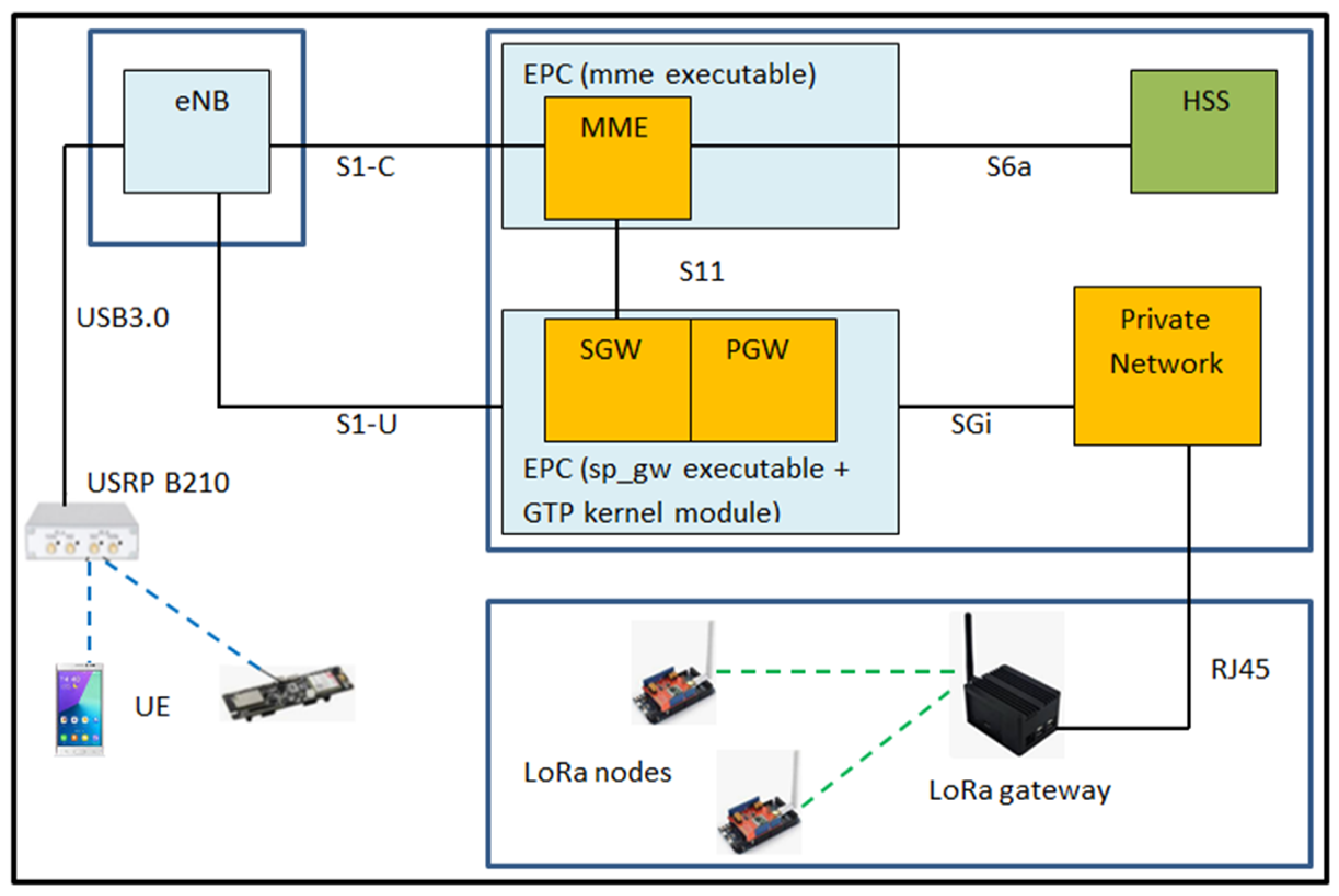
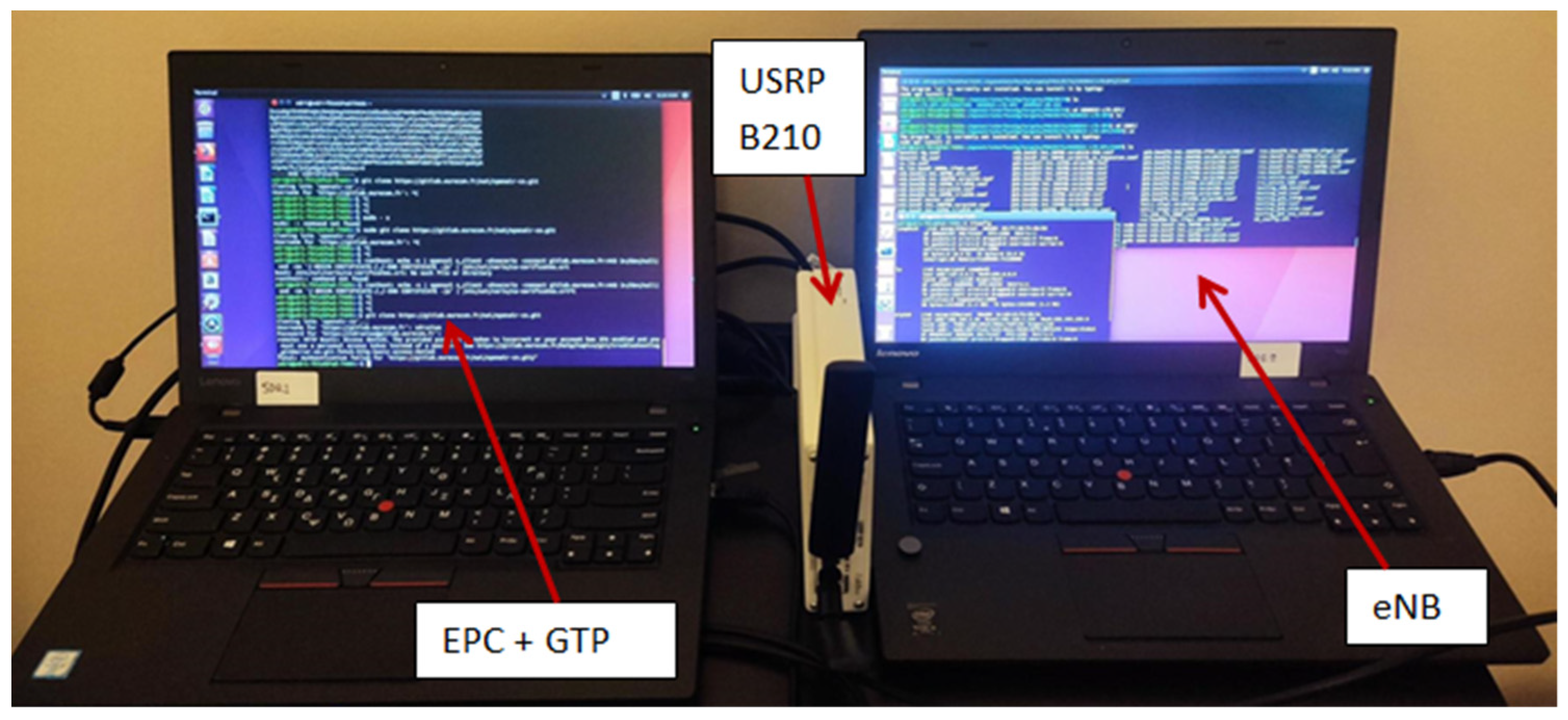
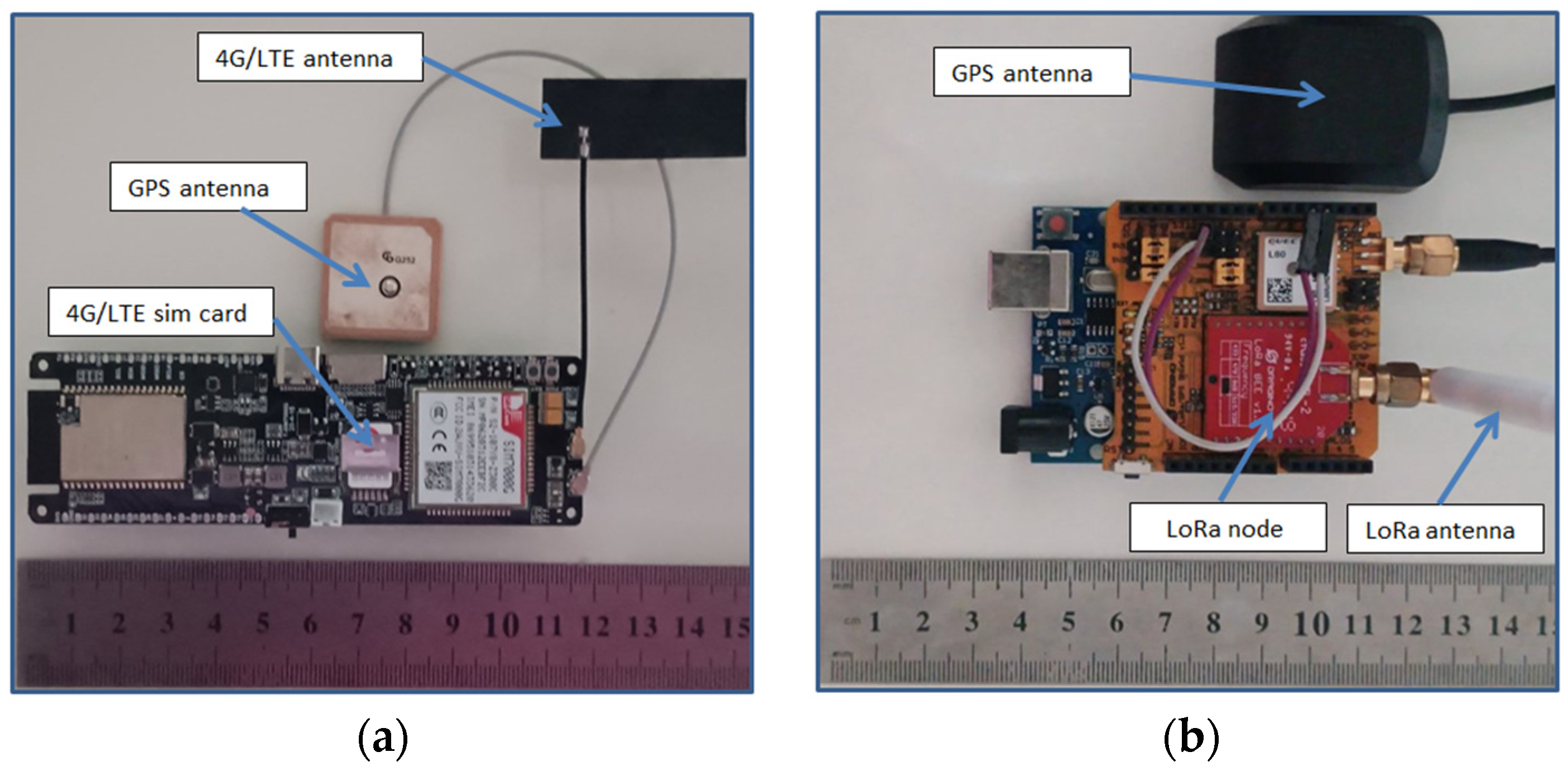
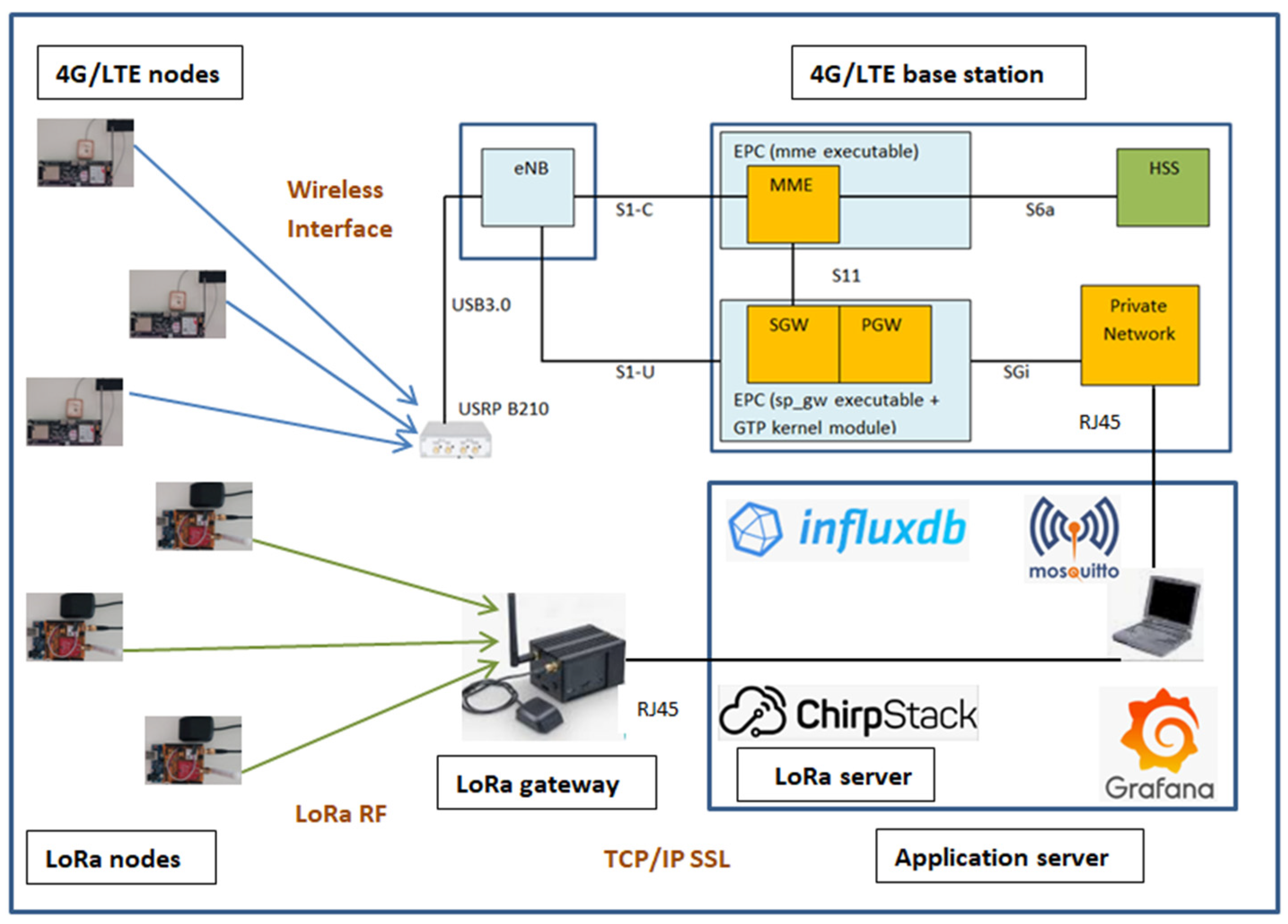
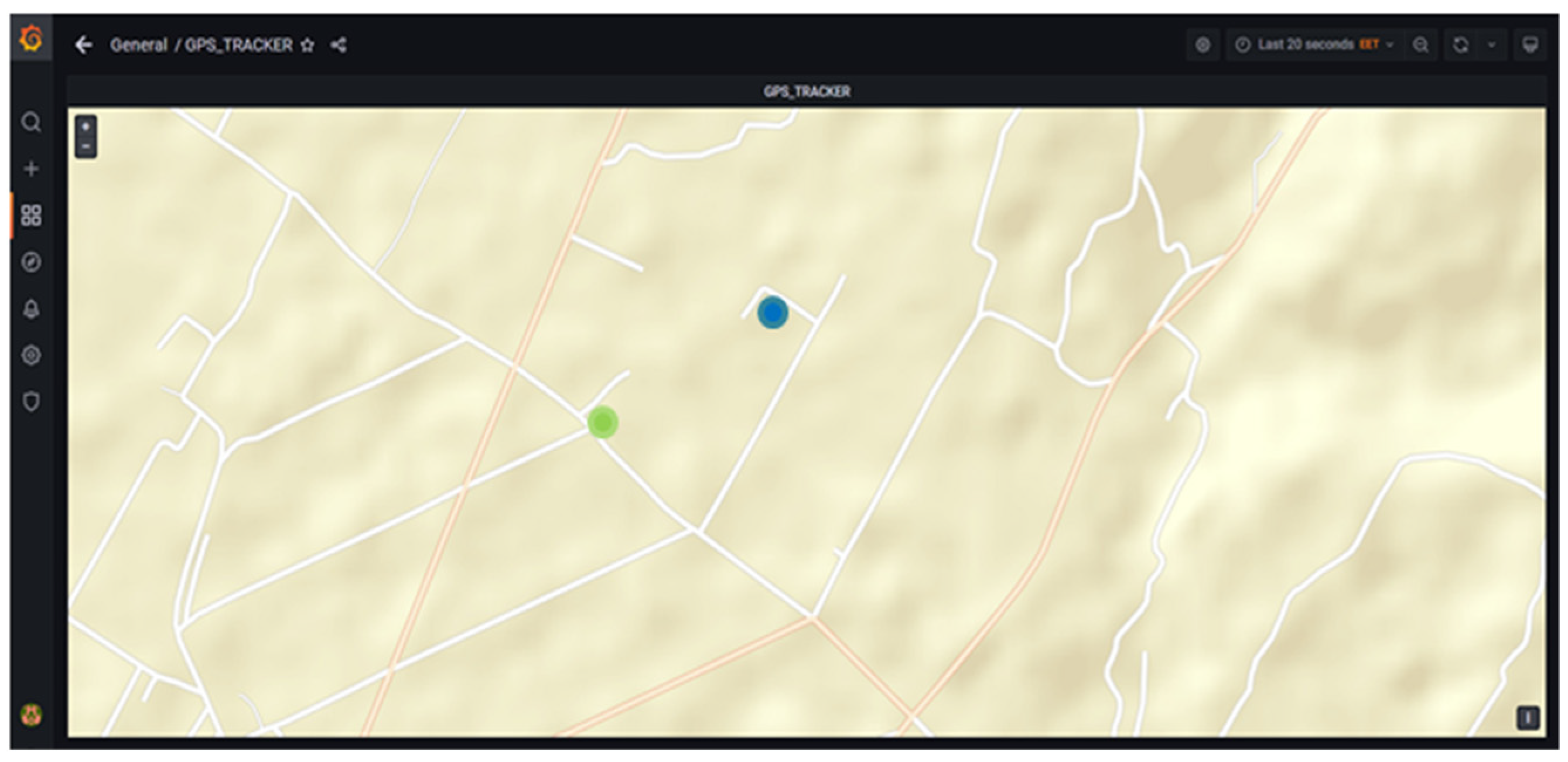
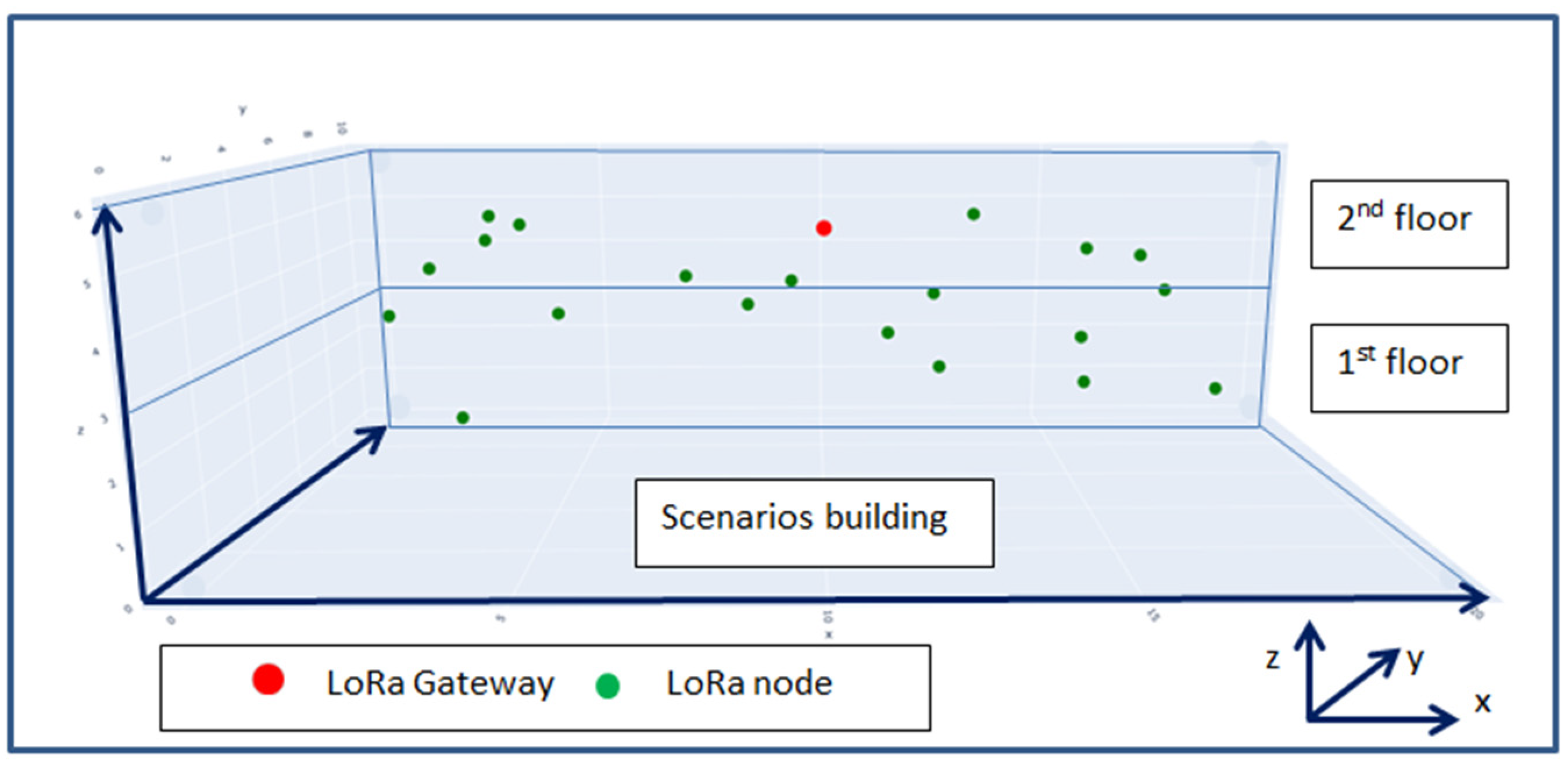


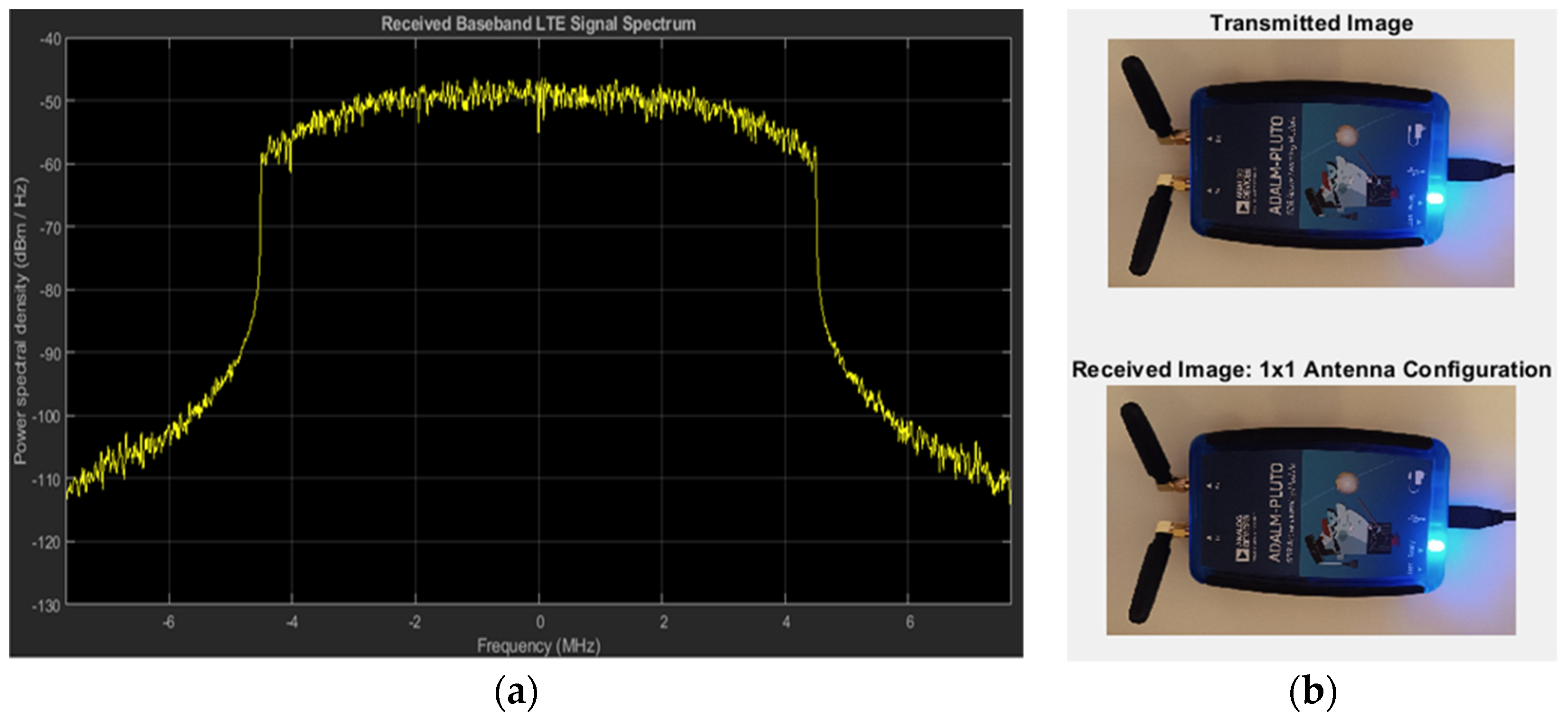
| Survey | Communication Technologies | Contribution | Evaluation |
|---|---|---|---|
| [3] | LTE/4G, SD-WAN | Emergency Evacuation System for Cruise Ships | Implementation |
| [11] | LPWAN, LoRa | Search and Rescue (SAR) Robot | Implementation |
| [12] | LPWAN, LoRa | Emergency Communication System in IoT | Implementation |
| [13] | LoRa, Bluetooth | Off-grid Emergency Communications | Simulation Implementation |
| [14] | LPWAN, Sigfox, GSM | IoT Surveillance System for Outdoor Fire Detection | Implementation |
| [15] | SD-WAN | Low-Cost Earthquake Early Warning System | Simulation Implementation |
| [16] | SDN, SD-WAN | Securing the Industrial IoT for Critical Infrastructure | Case study |
| [17] | SD-WAN, 4G | SD-WAN Technology in Power Communication Scenarios | Case study |
| [20] | 4G/LTE | Electric Power Emergency Communication Design | Case study |
| [21] | UAV, 5G and Beyond | Emergency Communication Systems in case of Disasters | Simulation Case study |
| [22] | USN | Communication Technologies in Emergency Situations | Case study |
| Proposed ECS | LTE/4G, SD-WAN LPWAN, LoRa | Emergency Communication System in case of Disasters | Simulation Implementation |
| Feature | SIGFOX | LoRa | NBIoT |
|---|---|---|---|
| Coverage Area | <12 km (160 dB) | <10 km (157 dB) | <15 km (164 dB) |
| Frequency | Unlicensed 900 MHz | Unlicensed 433, 868, 915 MHz | Licensed 7–900 MHz |
| Bandwidth | 100 kHz | <500 kHz | 200 kHz shared |
| Data Rate | <100 kbps | <10 kbps | <50 kbps |
| Network Reforming | Large | Large | Small to moderate |
| Feature | GSM | LTE-M | 5G (Targets) |
|---|---|---|---|
| Coverage Area | <15 km (164 dB) | <10 km (156 dB) | <12 km (160 dB) |
| Frequency | Licensed 800, 900 MHz shared | Licensed 700, 900, 1.4 MHz shared | Licensed 700, 900 MHz shared |
| Data Rate | 10 kbps | <1 Mbps | <1 Mbps |
| Network Reforming | Moderate (LTE reuse) | Small | Requires 5G NWs |
| Acronym | Abbreviation |
|---|---|
| eNB | Evolved Node B |
| EPC | Evolved Packet Core |
| EUTRAN | Evolved Terrestrial Radio Access Network |
| HSS | Home Subscriber Server |
| MME | Mobility Management Entity |
| OAI | Open Air Interface |
| PGW | Packet Data Network Gateway |
| SGW | Serving Gateway |
| UE | Mobile User Equipment |
| S1-C, S1-U, S11, S6a, SGi, RJ45, USB3.0 | Communication Protocols |
| USRP B210 | Software Defined Radio Device |
| LoRa gateway | LoRaWAN Gateway |
| LoRa nodes | LoRa User Equipment |
| LoRa Element | X Position (m) | Y Position (m) | Z Position (m) |
|---|---|---|---|
| gateway | 10.0 | 5.0 | 5.0 |
| node 1 | 15.8 | 4.2 | 4.6 |
| node 2 | 3.1 | 7.7 | 4.9 |
| node 3 | 2.9 | 3.7 | 4.5 |
| node 4 | 16.3 | 4.5 | 3.9 |
| node 5 | 15.3 | 6.7 | 2.5 |
| node 6 | 4.2 | 5.6 | 4.9 |
| node 7 | 2.8 | 8.2 | 4.3 |
| node 8 | 16.9 | 2.9 | 2.4 |
| node 9 | 11.9 | 2.6 | 2.9 |
| node 10 | 9.3 | 7.8 | 3.45 |
| node 11 | 8.6 | 3.4 | 3.8 |
| node 12 | 14.6 | 3.6 | 4.8 |
| node 13 | 13.0 | 7.1 | 4.9 |
| node 14 | 15.0 | 4.9 | 2.0 |
| node 15 | 12.5 | 9.0 | 2.9 |
| node 16 | 7.7 | 1.8 | 4.2 |
| node 17 | 5.7 | 1.0 | 4.6 |
| node 18 | 1.4 | 5.9 | 3.1 |
| node 19 | 11.4 | 8.1 | 2.3 |
| node 20 | 4.3 | 0.5 | 2.6 |
| Decoding Procedure | Result |
|---|---|
| Generating LTE transmit waveform: Packing image data into 30 frame(s). | Setting channel map to ‘1’. |
| SDR hardware sampling rate configured to capture 50 LTE RBs. | Starting a new RF capture. |
| Establishing connection to hardware. | Corrected a frequency offset of 2.666334 × 10−1 Hz. Detected a cell identity of 88. Corrected a timing offset of 29,371 samples. |
| Performing DL-SCH Decode for frame 1 of 30 in burst: | Successful MIB Decode. Frame number: 713. Retrieving decoded transport block data. |
| Performing DL-SCH Decode for frame 2 of 30 in burst: | Successful MIB Decode. Frame number: 714. Retrieving decoded transport block data. |
| …………. | …………. |
| Performing DL-SCH Decode for frame 29 of 30 in burst: | Successful MIB Decode. Frame number: 711. Retrieving decoded transport block data. |
| Performing DL-SCH Decode for frame 30 of 30 in burst: | Successful MIB Decode. Frame number: 712. Retrieving decoded transport block data. |
| Recombining received data blocks: | EVM peak = 12.543% EVM RMS = 1.060% BER = 0.00000. Number of bit errors = 0. Number of transmitted bits = 8,084,832. |
| Constructing image from received data. |
Disclaimer/Publisher’s Note: The statements, opinions and data contained in all publications are solely those of the individual author(s) and contributor(s) and not of MDPI and/or the editor(s). MDPI and/or the editor(s) disclaim responsibility for any injury to people or property resulting from any ideas, methods, instructions or products referred to in the content. |
© 2023 by the authors. Licensee MDPI, Basel, Switzerland. This article is an open access article distributed under the terms and conditions of the Creative Commons Attribution (CC BY) license (https://creativecommons.org/licenses/by/4.0/).
Share and Cite
Cheimaras, V.; Peladarinos, N.; Monios, N.; Daousis, S.; Papagiakoumos, S.; Papageorgas, P.; Piromalis, D. Emergency Communication System Based on Wireless LPWAN and SD-WAN Technologies: A Hybrid Approach. Signals 2023, 4, 315-336. https://doi.org/10.3390/signals4020017
Cheimaras V, Peladarinos N, Monios N, Daousis S, Papagiakoumos S, Papageorgas P, Piromalis D. Emergency Communication System Based on Wireless LPWAN and SD-WAN Technologies: A Hybrid Approach. Signals. 2023; 4(2):315-336. https://doi.org/10.3390/signals4020017
Chicago/Turabian StyleCheimaras, Vasileios, Nikolaos Peladarinos, Nikolaos Monios, Spyridon Daousis, Spyridon Papagiakoumos, Panagiotis Papageorgas, and Dimitrios Piromalis. 2023. "Emergency Communication System Based on Wireless LPWAN and SD-WAN Technologies: A Hybrid Approach" Signals 4, no. 2: 315-336. https://doi.org/10.3390/signals4020017
APA StyleCheimaras, V., Peladarinos, N., Monios, N., Daousis, S., Papagiakoumos, S., Papageorgas, P., & Piromalis, D. (2023). Emergency Communication System Based on Wireless LPWAN and SD-WAN Technologies: A Hybrid Approach. Signals, 4(2), 315-336. https://doi.org/10.3390/signals4020017










